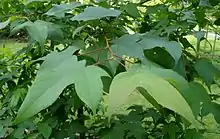Liquidambar acalycina
Liquidambar acalycina, Chang’s sweet gum, is a species of flowering plant in the family Altingiaceae (formerly Hamameliaceae), native to southern China. Growing to 30–50 ft (9.1–15.2 m) tall by 20–30 ft (6.1–9.1 m) broad, It is a medium-sized deciduous tree with three-lobed maple-like leaves that turn red in autumn before dropping. It is monoecious, meaning that both male and female flowers appear on the same plant. The flowers are insignificant, yellow/green in colour, and are followed by small gum-balls that persist on the tree until winter. The wood exudes a sweet-smelling resin when pierced, giving the tree its common name.[3]
| Liquidambar acalycina | |
|---|---|
 | |
| Scientific classification | |
| Kingdom: | Plantae |
| Clade: | Tracheophytes |
| Clade: | Angiosperms |
| Clade: | Eudicots |
| Order: | Saxifragales |
| Family: | Altingiaceae |
| Genus: | Liquidambar |
| Species: | L. acalycina |
| Binomial name | |
| Liquidambar acalycina | |
Liquidambar acalycina is cultivated as an attractive ornamental tree for parks and gardens, and is hardy down to −15 °C (5 °F) or less. It requires cultivation in reliably moist, acid to neutral soil in full sun or partial shade. The cultivar ‘Burgundy Flush’, with leaves opening purple, then green, then burgundy red in autumn, has gained the Royal Horticultural Society’s Award of Garden Merit.[4][5]
Characteristics
Liquidambar acalycina is a deciduous tree that has a brown to black colored bark with a conical/pyramidal shape. It matures quickly to be of a medium height ranging at 10m in height, and 6m width.[6] The leaves have three lobes which make the tree similar to a Maple. However, they are more star shaped than maple leaves.[7] The leaves emerge with a burgundy color in spring but as they grow and mature in summer, they become green which indicates their increasing ability to photosynthesize.[8] When nearing fall the colors turn back into a red to purple color.[9] During the months of April to May, monoecious flowers begin to bud with yellow-green colors, but are insignificant for pollination in attracting pollinators. The fruit of this tree is a dark brown black color. This tree serves as a shade tree for gardens.[10] This Sweetgum Tree prefers soil that is acidic, clay-based, and sunlight.[11]
Distribution
This tree is native to East Asia, specifically in Southeast China.[12] Other species can be found in Southern China and the United States of America.[13]
Disease and Infestation
This tree is generally stable in the specific climates in which it exists. However, some insects can infest the tree, such as webworms, bagworms, caterpillars, leaf miners, and borers.[14] Other issues that some trees experience in this species are canker and bleeding necrosis, and can become extreme. If the plant is growing in alkaline soils, the trees may experience iron chlorosis. Other issues include dark spots on leaves, and wood rot.[15]
References
- "Liquidambar acalycina". The Plant List. Retrieved 25 March 2018.
- Hamamelidaceae Liquidambar acalycina H.T. Chang. 1959. International Plant Names Index. Retrieved 25 March 2018.
- "Liquidambar acalycina". Missouri Botanical Garden. Retrieved 25 March 2018.
- "RHS Plantfinder - Liquidambar acalycina 'Burgundy Flush'". Retrieved 25 March 2018.
- "AGM Plants - Ornamental" (PDF). Royal Horticultural Society. July 2017. p. 60. Retrieved 25 March 2018.
- Wu, Wei; Shi, Suhua; Boufford, David; Huang, Yelin; Zhou, Renchao (26 November 2009). "Molecular evidence for natural intergeneric hybridization between Liquidambar and Altingia". Journal of Plant Research. 123 (2): 231–239. doi:10.1007/s10265-009-0275-z. PMID 19941029. S2CID 26961076.
- Hoey, Margaret; Parks, Clifford (1994). "Genetic Divergence in Liquidambar styraciflua, L. formosana, and L. acalycina". American Society of Plant Toxonomists. 19 (2): 308–316. JSTOR 2419604.
- "Seasonal Changes in Photosynthetic Traits of the Co-occurring Evergreen and Deciduous Broad-leaved Species in a Montane Forest of Mao'er Mountain,Guangxi". Journal of Tropical and Subtropical Botany. March 2008.
- Kan-Kan, Shang; Song, Kun; Liang-Jun, Da (2016). Ecology of Relict Tertiary Deciduous Trees in Subtropical China. Cham Springer. pp. 149–167.
- "Acalycina". Leafland.
- "Sweet Gum Acalycina". Barcham.
- Iranpour, Reza; Zhao, Ji; Wang, Aijie; Yang, Fenglin; Li, Xinyong (May 2012). "Patterns of Indigenous Tree Species Distribution in Guangdong Province and the Implications for Tree Introduction". Advanced Materials Research. 518–523: 5324–5329. doi:10.4028/www.scientific.net/AMR.518-523.5324. S2CID 137531778.
- Piggs, Kathleen; Wen, Jun (1 March 2004). "Anatomically preserved Liquidambar (Altingiaceae) from the middle Miocene of Yakima Canyon, Washington state, USA, and its biogeographic implications". American Journal of Botany. 9 (3): 499–509. doi:10.3732/ajb.91.3.499. PMID 21653405.
- Beeboon, Jamjam; Takamatsu, Susumu (July 2018). "New records of Erysiphe sect. Uncinula spp. (Erysiphales) from Thailand and E. liquidambaris var. acalycinae". Mycoscience. 58: 236–241. doi:10.1016/j.myc.2017.01.002.
- Zheng, Z-M; Jiang, G-F (21 February 2007). "A checklist of Tetrigoidea (Orthoptera) from Zuojiang Area, southwestern Guangxi, China, with the description of two new species". Journal of Natural History. 40 (19–20): 1253–1258. doi:10.1080/00222930600795504. S2CID 84990238.